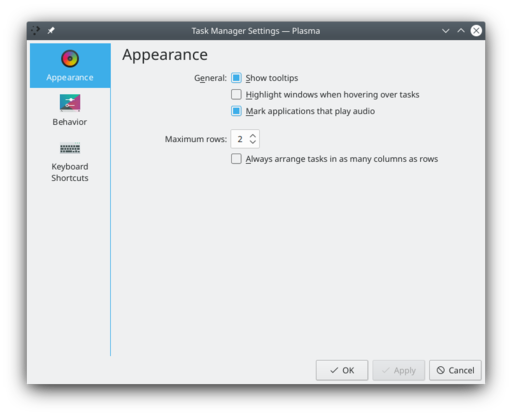Plasma/Tasks/pl: Difference between revisions
Created page with "=== Widget Menedżera zadań ===" |
Created page with "'''Menedżer zadań''' to obecnie widget, co oznacza, że można go umieścić gdziekolwiek. Na przykład można dodać nowy panel do górnej części ekranu i umieścić tam..." |
||
| Line 8: | Line 8: | ||
=== Widget Menedżera zadań === | === Widget Menedżera zadań === | ||
'''Menedżer zadań''' to obecnie widget, co oznacza, że można go umieścić gdziekolwiek. Na przykład można dodać nowy panel do górnej części ekranu i umieścić tam '''Menedżer zadań''' lub na pulpicie, jeśli wolisz. Można nawet mieć kilka jego kopii w różnych miejscach. | |||
Whenever you start an application you will see a new tab in the '''Task Manager''' showing the icon of the application and the title of the window that was opened. | Whenever you start an application you will see a new tab in the '''Task Manager''' showing the icon of the application and the title of the window that was opened. | ||
Revision as of 11:39, 15 June 2014
Menedżer zadań Plasmy

Menedżer zadań dostarcza prosty dostęp do uruchomionych aplikacji. Jest on położony w środkowej części panelu. Jeśli okno aplikacji zostało umieszczone za innymi oknami lub jeśli zostało zminimalizowane, można je przywrócić do gotowości użycia przez kliknięcie w zakładkę Menedżera zadań.
Widget Menedżera zadań
Menedżer zadań to obecnie widget, co oznacza, że można go umieścić gdziekolwiek. Na przykład można dodać nowy panel do górnej części ekranu i umieścić tam Menedżer zadań lub na pulpicie, jeśli wolisz. Można nawet mieć kilka jego kopii w różnych miejscach.
Whenever you start an application you will see a new tab in the Task Manager showing the icon of the application and the title of the window that was opened.
If you click on the tab corresponding to the active window then that window will be minimized. If there are still windows that have not been minimized then the frontmost of them will become active. If you click on the tab of a minimized window it will be displayed in front of all other windows, and it will become active. If you click on the tab of a window which is displayed behind other windows it will be brought in front of all other windows, and it will become active.
You can also right-click a tab to bring up the context menu. This gives you a number of options. For example, you can set which virtual screens the windows are displayed on, and you can close the window.

If you have many windows opened the tabs may be grouped. In that case you will see a number with a small arrow above in the right hand side of the tab. Clicking on such a tab will bring up a list of tabs for individual windows that you can use just like ordinary Task Manager tabs. Right-clicking a group gives you the option to close all windows in that group.
You can also activate windows by holding Alt down while pressing Tab one or more times. This way you browse through all windows whether displayed or minimized.
Configuration
To access the Task Manager settings menu, right-click on it and click . If you have troubles to click on it and not in one of its tasks, you can first click the panel toolbox, so wherever you click on the Task Manager will work.

There you can change its behavior. The following settings are particularly useful:
- Grouping and Sorting
- Grouping can be by program name, manually, or not at all. (You can also choose to only enable grouping if the taskbar is full.) Similarly, Sorting defaults to , but it can also be , , or .
- Only Show Tasks from the Current Desktop
- A checkbox on the Filters section.
- Have More than One Row on the Taskbar
- If you use many applications at one time you may find it advantageous to set and then .
- Showing or Hiding Tooltips
- A simple checkbox in the Appearance section of the page.

